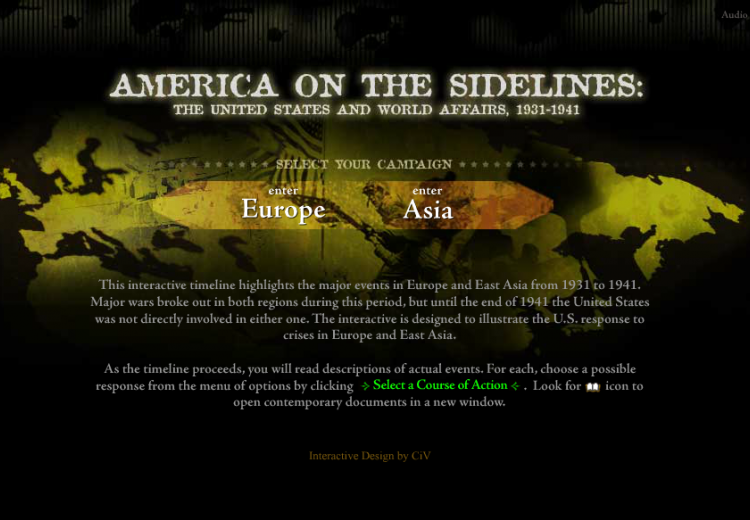From Neutrality to War: The United States and Europe, 1921–1941

A comprehensive student interactive giving the user a full scope of America's political and diplomatic responses to world events between the two world wars.
"Providing for the prohibition of the export of arms, ammunition, and implements of war to belligerent countries; the prohibition of the transportation of arms, ammunition, and implements of war by vessels of the United States for the use of belligerent states; for the registration and licensing of persons engaged in the business of manufacturing, exporting, or importing arms, ammunition, or implements of war; and restricting travel by American citizens on belligerent ships during war."
~ "Neutrality Act" of August 31, 1935
In the years after World War I Americans quickly reached the conclusion that their country's participation in that war had been a disastrous mistake, one which should never be repeated again. During the 1920s and 1930s, therefore, they pursued a number of strategies aimed at preventing war. This curriculum unit includes a comprehensive student interactive giving the user a full scope of America's political and diplomatic responses to world events between the two world wars.
Guiding Questions
How did disillusionment with World War I shape U.S. foreign policy during the 1920s?
Did the neutrality laws of the 1930s represent an effective U.S. response to world affairs?
What were the short and long term effects of the U.S. decision to end its policy of neutrality?
Which side offered a more convincing argument: the "internationalists" or the "isolationists"?
What role should the United States play in world affairs?
Learning Objectives
Analyze the reasons why antiwar sentiments spread across the United States after World War I.
Assess the U.S. foreign policy initiatives of the 1920s that aimed toward the prevention of war.
Evaluate the Five-Power Treaty and the Kellogg-Briand Pact as means of preventing war.
Explain the "Merchants of Death" thesis and how it shaped the U.S. approach to neutrality.
Organize the location and chronology of major events between 1935 and 1941 and evaluate how they shaped the debate over U.S. neutrality.
Analyze President Roosevelt's arguments regarding neutrality and assess the overall effectiveness of U.S. neutrality policy during this period.
Assess the strengths and weaknesses of the "internationalist" and "isolationist" positions regarding U.S. policy at the outset of WWII.
Create an original argument regarding the best course forward for U.S. foreign policy at the outset of WWII.
